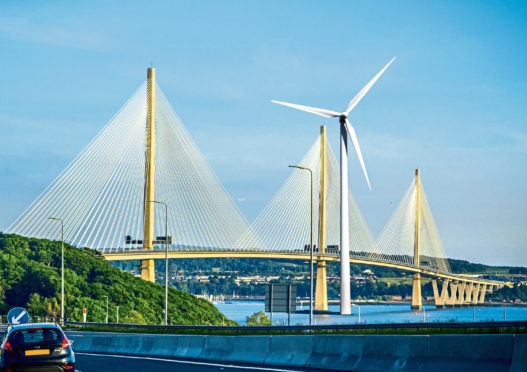A new generation of giant onshore wind turbines, almost as tall as the Eiffel Tower, is heading for Scotland as efforts to achieve green energy targets are stepped up, according to a firm of property experts.
Galbraith is in negotiations with a number of developers about installing machines that would stand around 820ft from the ground to the tip of their blades at Scottish and English sites.
More than twice the height of most of the first generation of turbines erected at wind farms around the country, they would be taller than the 683ft high Queensferry Crossing over the River Forth.
Mike Reid, Galbraith’s head of utilities, said: “The maths of wind turbines is relatively simple: bigger is better.”
According to the Edinburgh-based firm, the trend results from a UK commitment to zero net greenhouse commitments by 2050, which requires replacing coal and gas with renewables to generate power.
Wind is currently the most productive green technology and contributed 24.2% of Britain’s electricity last year.
Among the new generation of turbines, manufacturer Vestas’ V162-6.2MW machine is taller than the length of two football pitches and produces 22 gigawatt-hours (GWh)-a-year, enough to power more than 6,150 homes. An offshore version of the machine generates 80GWh.
Other companies in the sector, including Siemens Gamesa and Enercon, have also developed their own mega-turbines.
Following the end of the Renewables Obligation scheme in 2017, onshore wind farm owners are now looking at how to maximise the generating potential of their sites.
Mr Reid said: “Specifically there are two ways to produce more power from the wind in a given area.
“The first is to erect turbines with bigger rotors and blades to cover a wider area, which increases the capacity of the turbine, and the second is to increase the tip height higher into the sky where the wind blows more steadily.
“That increases the turbine’s capacity factor, which is the total amount of power it produces relative to its potential.”
He added: “The rise in renewables is, in this case, literally all one-way. To create the same amount of power you either have a larger number of smaller turbines or lower number of bigger, more efficient ones.
“The public mood appears to support the latter, and this also makes sense economically.
“This explains why we are involved in negotiations with a number of developers about installing up to 250-metre (820ft) turbines at specific sites in England and Scotland.”
Opponents of onshore wind farms frequently raise concerns about issues including their impact on the landscape, the dangers they pose to birds and problems with transportation, infrastructure and shadow flicker caused by the rotating blades.
Galbraith said that, while not everyone welcomed turbines, wind generation enjoyed up to 74% public support, according to UK Government polling.
The company added: “As well as all the environmental benefits, people see economic advantage in the £35 billion total invested in the UK’s 1,500 operational wind farms.
“They bring jobs and customers to sometimes remote areas as well as ‘planning gain’, whereby developers must spend on social and amenity projects as a planning quid pro quo.”
